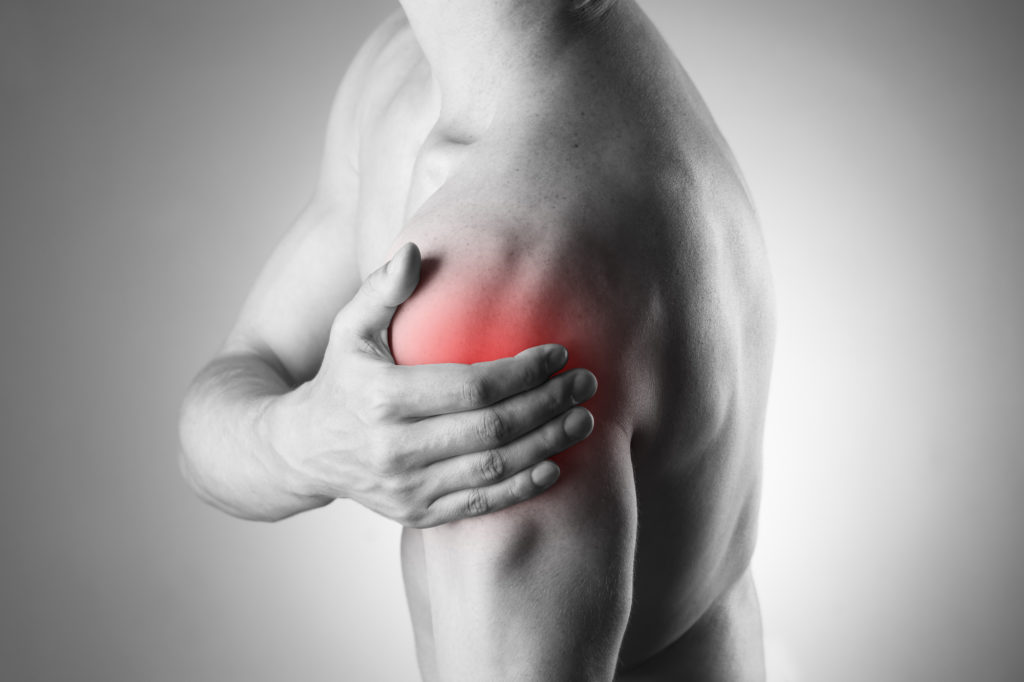Shoulder pain affects 18-26% of adults, making it a common cause of discomfort that people deal with, and as such, treatment to relieve shoulder pain is a must for the health of a significant portion of the population. You rely on your shoulders for being able to fulfill your daily obligations and do simple tasks. If your shoulder hurts, it makes your everyday life harder, and left untreated, it can spiral into more than just a persistent pain, but severely impact your quality of life and impair your ability to do activities.
Shoulder pain isn’t something you just need to grin and bear. There are several different ways you can relieve shoulder pain. Here’s what you need to know about shoulder pain, its symptoms, causes, how it’s diagnosed, and how it’s treated.
Symptoms Of Shoulder Pain

Your shoulder is meant to give you significant range of motion and be able to withstand a lot of physical demands. Because it’s used so much and because of its ball-and-socket joint, this means that your shoulder is more likely to be dislocated than any other joint in your body, as well as leading to tears and other such injuries. Sometimes, shoulder pain just results from sleeping on it funny, but if it’s persistent, shoulder pain can manifest in a number of different ways.
Common symptoms of shoulder pain include:
- Intense pain
- Swelling
- Deformation
- Inability to use your shoulder
- Weakness in your arm or hand
- Throbbing
- Strain
- Limited range of motion
- Inflammation
- Bursitis
- Tendonitis
- Rotator cuff inflammation
- Arm pain
Common Causes Of Shoulder Pain
With all the stress your shoulder is put under, there are many different causes for shoulder pain. Shoulder pain can be caused by something as severe as a car accident or altercations or sports injuries, or it can be as simple as a sprain. When you want to relieve shoulder pain, it’s important to uncover the underlying cause, to ensure effective treatment. Knowing the common causes won’t only help you and your medical provider relieve shoulder pain, but also help you work to prevent it in the future.
Common causes of shoulder pain include:

- Overuse
- Arthritis
- Poor posture
- Bursitis
- Dislocation
- Sprain
- Broken arm
- Broken collarbone
- Tendinitis
- Tendon rupture
- Heart attack
- Rotator cuff injury
- Separation
- Osteoarthritis
- Frozen shoulder
- Torn cartilage
- Fracture
- Impingement
- Bone spurs
- Referred pain
This is by no means a comprehensive list of all the potential causes of shoulder pain, simply some of the most common ones. If you’re trying to relieve shoulder pain, it’s best to consult with a professional, to diagnose the underlying cause of it to ensure that you don’t just relieve shoulder pain, but that you can work to treat it and banish it for good.
Diagnosing Shoulder Pain
Shoulder pain is diagnosed in a number of different ways. Typically, your doctor or physical therapist will conduct a physical exam in order to check for any spinal or neck issues, check your range of motion, and potentially have tests done, such as x-rays or CT scans or MRI’s or other such imaging tests so that they can get a proper look at your shoulder to determine what’s causing your pain and how best to relieve shoulder pain as your specific case calls for.
Treating Shoulder Pain
Depending on what’s causing it, you may be able to relieve shoulder pain with at home treatments. Rest, pain killers, and heat or ice packs can reduce swelling and pain, as can exercises and stretches. If you work with a physical therapist, they’ll be able to guide you through exercises and stretches that you can do both with them and by yourself in order to relieve shoulder pain and regain mobility and strength.

Some common exercises that people do to relieve shoulder pain include across-the-chest stretches, shoulder circles, downward dog pose, and child’s pose, among others.
When you see a physical therapist to relieve shoulder pain, they can use a number of different treatments, such as manual therapy which will stimulate blood flow and help with mobilization, dry needling, compression therapy, trigger point release, and other such treatments, personalized to you and what you need.
Sometimes, in more severe cases, you may need a doctor’s help to relieve shoulder pain. If it’s because of dislocation or fractures or separations, a doctor will get it back into its proper position. In other cases, you may need surgery.
No matter the cause of your shoulder pain, relieving it will involve strengthening and stretching exercises as part of your treatment plan, to get it back to working condition, and to help prevent shoulder pain in the future.
Do You Need Help With Shoulder Pain?
Wasatch Peak Physical Therapy is here to help you relieve shoulder pain. Our trained experts will get your shoulder back to normal with our variety of treatment options and advise you on exercises you can do on your own. Don’t hesitate to contact us today in order to get started on relieving your shoulder pain.

Leave a Reply